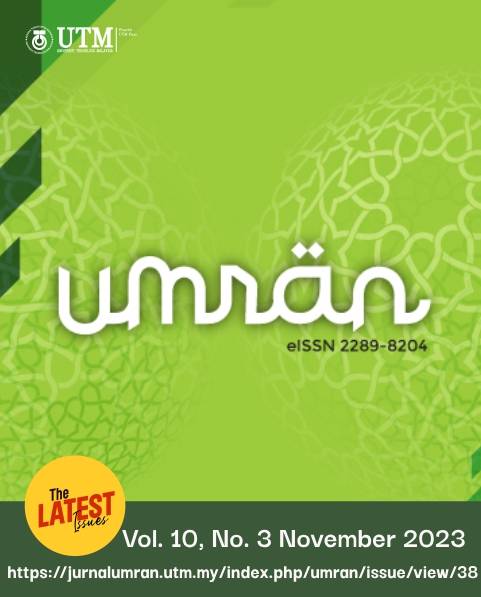Sistem Teras Perbankan Dalam Ekosistem Kontrak Syariah Di Malaysia (Core Banking System in Shariah Contract Ecosystem in Malaysia)
DOI:
https://doi.org/10.11113/umran2023.10n3.462Keywords:
Islamic Banking and Finance, IFSA 2013, Islamic banking, Islamic core banking system, Shariah contract.Abstract
Islamic core banking system is an enabler to banking activity that provides agile platform to achieve the corporate objective of Islamic banking as well as to meet Shariah compliance aspect. In Malaysia, Shariah compliance principle in Islamic finance has been stipulated in Part IV, Division 1, Islamic Financial Services Act 2013 (“IFSA 2013”). Nevertheless, the suitability of methodology on the development of Islamic core banking system in Malaysia is less discussed qualitatively in previous studies. Thus, the objective is to study on methodology of Islamic or Shariah contract based core banking system’s development that is suitable in Malaysia. This study found that the development of Islamic core banking system shall respect Shariah contract ecosystem in Malaysia. Shariah contract policy document issued by Central Bank of Malaysia (“BNM”) is resulting from Malaysia’s Shariah contract ecosystem in line with provisions of Shariah compliance under section 28 and 29, IFSA 2013. From these legal provisions, the stakeholders shall respect the power given to BNM, and Shariah contract policy document shall be the main reference in translating Shariah contract requirements onto each process within Islamic core banking system in Malaysia.
References
Akta Perkhidmatan Kewangan Islam 2013 [Akta 759].
Alam, N., Zainuddin, S.S., & Rizvi, S.A.R. (2018). “Ramifications of varying banking regulations on performance of Islamic Banks.” Borsa Istanbul Review, XX, p 1-16.
Farrar, S. (2012). “Islamic Banking and Finance – The Australian Way.” Islamic Banking & Finance: Principles, Instruments & Operations, 561-592. Selangor: CLJ Publication.
Gazali, H.M., Hassan, R., Nor, R.M., & Rahman, H.M.M. (2017). “Re-inventing PTPTN Study Loan with Blockchain and Smart Contracts.” IEEE: 8th International Conference on Information Technology (ICIT), 751-754.
Halal Ecosystem Prospects For Global Growth. (2015). <http://www.mifc.com/index.php?ch=28&pg=72&ac=143&bb=uploadpdf> Tarikh Akses: 4 Ogos 2018.
Hasan, A. (2011). Fundamentals of Shari’ah in Islamic Finance. Kuala Lumpur: IBFIM.
Hassan, M.K. & Aliyu, S. (2018). “A contemporary survey of islamic banking literature.” Journal of Financial Stability, 34, pp 12-43.
Hussin, M.H.S.M., & Hussin, M.H.M. (2011). Application of Shari’ah in Islamic Finance. Edisi ke-2. Kuala Lumpur: IBFIM.
Ibn ‘Āshūr, Muhammad al-Tahir. (2006). Treatise on Maqasid al-Shari’ah. Diterjemahkan oleh Mohamed El-Tahir El-Mesawi. Washington: The International Institutue of Islamic Thought.
InfrasoftTech featured in Gartner’s Market Guide for Islamic Core Banking Systems. (2016). <http://www.infrasofttech.com/sites/default/files/InfrasoftTech%20featured%20under%20Gartner_2nd%20May%20%281%29.pdf> Tarikh Akses: 18 Julai 2017
Laldin, M.A. & Furqani, H. (2018). “Islamic Financial Services Act (IFSA) 2013 and the Sharīʿah-compliance requirement of the Islamic finance industry in Malaysia.” ISRA International Journal of Islamic Finance, 10(1), 94-101.
Laldin, M.A., & Furqani, H. (2013). “Developing Islamic Finance in the Framework of Maqasid al-Shari'ah.” International Journal of Islamic and Middle Eastern Finance and Management, 6(4), 280-283.
Majdalawieh, M., Marir, M. & Tiemsani, I. (2017). “Developing Adaptive Islamic Law Business Processes Models for Islamic Finance and Banking by Text Mining the Holy Qur’an dan Hadith,” IEEE: 15th International Conference on Dependable, Autonomic and Secure Computing, 1278-1283.
Mohd Rizal Abdul Rahman, temubual, 22 Ogos 2022.
Mohd Zamri Yusoff, temubual, 23 Ogos 2022.
Nafees, M. (2012). “Regional Implementation of Islamic Finance: The Middle East Experience.” Islamic Banking & Finance: Principles, Instruments & Operations. 485-500. Selangor: CLJ Publication.
Noordin, N., Noor, N.L.M. & Samicho, Z. (2014). “Strategic Approach to Halal Certification System: An Ecosystem Perspective.” Procedia - Social and Behavioral Sciences, 121, 79–95.
Othman Abdullah, temubual, 1 September 2022.
Retail Banking. (2014). <http://gifr.net/gifr2014/ch_05.pdf> Tarikh Akses: 6 September 2022.
Ribadu, M.B. & Rahman, W.N.W.A. (2016). “A Generic Framework for E-Commerce Requirements to Comply with Shariah in Business-To-Consumer Perspective.” IEEE: SAI Computing Conference, 752-757.
Ridwan, A.Y. & Kamili, I. (2015). “Designing an Integrated Core Banking System For a Medium-Scale Sharia Bank In Indonesia.” 3rd International Conference on Information and Communication Technology (ICoICT), 537-542.
Safiullah, M., & Shamsuddin, A. (2018). “Risk in Islamic banking and corporate governance.” Pacific-Basin Finance Journal, 47, 129-149.
Sulaiman, M.Z.M, Noordin, N., Noor, N.L.M., Suhaimi, A.I.H. & Isa, W.A.R.W. (2016). “A Preliminary Study of Halal Virtual Inspection: A Case of Halal Certification in Malaysia.” IEEE: 6th International Conference on Information and Communication Technology for the Muslim World, 93-98.
Trakic, A. (2012). “Islamic Banking and Finance in United Kingdom.” Islamic Banking & Finance: Principles, Instruments & Operations. 501-534. Selangor: CLJ Publication.
Trakic, A. (2012a). “Islamic Banking and Finance in France.” Islamic Banking & Finance: Principles, Instruments & Operations 535-560. Selangor: CLJ Publication.
Yaakob, H. & Mohamad, A.M. (2012). “The Development of Islamic Finance in Malaysia.” Islamic Banking & Finance: Principles, Instruments & Operations. 463-484. Selangor: CLJ Publication.
Downloads
Published
How to Cite
Issue
Section
License
Copyright (c) 2023 Penerbit UTM Press

This work is licensed under a Creative Commons Attribution-NonCommercial-NoDerivatives 4.0 International License.
Copyright of articles that appear in UMRAN - International Journal of Islamic and Civilizational Studies belongs exclusively to Penerbit Universiti Teknologi Malaysia (Penerbit UTM Press). This copyright covers the rights to reproduce the article, including reprints, electronic reproductions or any other reproductions of similar a nature.
















